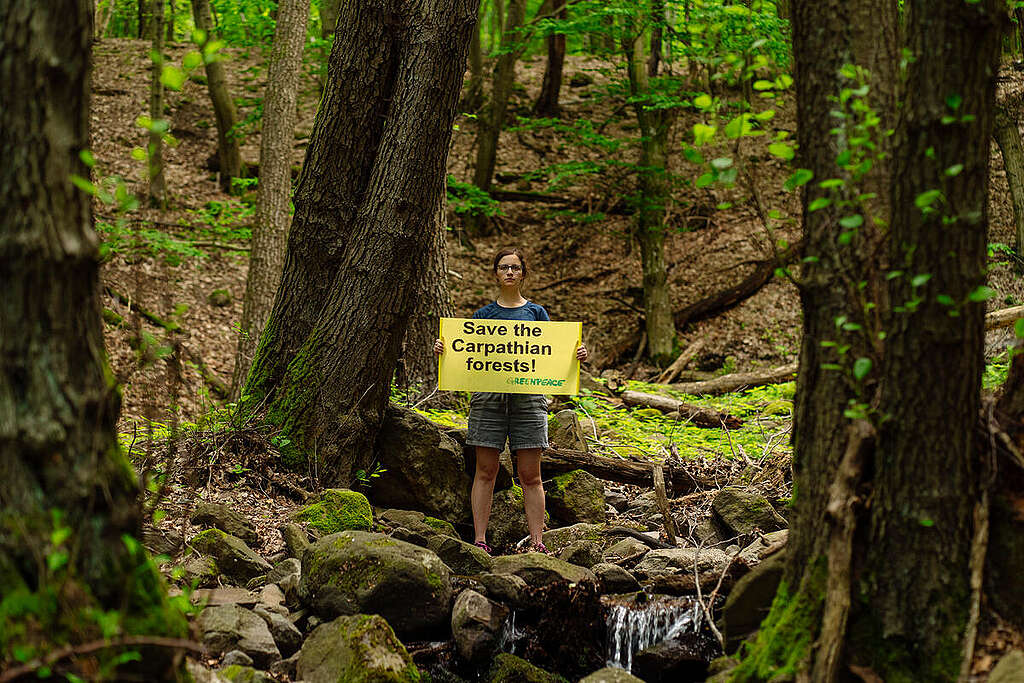Imagine a six-week expedition through the forest just exploring. You’d look forward to seeing the surrounding tall trees, leaves dancing and swaying to the gentle breeze, the smell of the forest and crunch of leaves as they give way to exploration deeper into the forestside while spotting rare animals, marvelling at the rich biodiversity found in natural forests. Well, in reality, beyond the beauty, loss and devastation was also witnessed by the team of Greenpeace CEE volunteers, staff and activists who embarked on an adventurous journey over five countries through the Carpathian mountains.

The Carpathian mountain range is rich in ecological value and spans through Central Europe. The expedition team dubbed Mobile Rescue Station (MRS) had stops in Romania, Ukraine, Hungary, Slovakia and Poland with one mission in mind; to bring the story of the lack of protection of old growth forests in the Carpathian region to the limelight.
Expectation Vs Reality
In theory, taking into account all European commitments and obligations included in the EU biodiversity strategy for 2030 and Kunming-Montreal Global Biodiversity Framework, European Union should have one of the most progressive and systems of nature protection (with a special focus on the protection of all EU’s remaining old-growth forests and in the world. But the reality looks different.
Starting in Romania, the activists encompassed direct actions, field trips to desktop research. In the Făgăraș Mountains, the team explored a old-growth forest with the Threatened Ancient Forests (TAF) designation, where the ominous presence of logging roads threatens to shatter the untouched tranquillity of this precious ecosystem.
Entering Ukrainian Carpathians, the team had a shocking finding: European companies are complicit in the destruction of old growth forests, the timber from which is sold throughout the European Union. This has a devastating impact on the Carpathian wilderness.
In the Mátra mountain range in Hungary, the expeditioners were confronted with cleared hillsides in a national park and Natura 2000 area. 45% of Hungary’s forests are protected in theory, but in reality only 5.6% of them are managed by national parks for nature conservation.
After crossing the border to Slovakia, the journey continued through no-intervention zones. showing that forests and biodiversity can regenerate itself if left untouched. On the other hand, many places in Tatra mountains salvage cutting and clear cuts are ongoing that threatens the already declining population of capercaillies – the largest bird of all extant grouse species.
In Poland, the team visited several sites where Polish State Forests are destroying unique natural habitats. Greenpeace activists monitored the flow of trucks with timber on one of the roads in Bieszczady Mountains – the wildest part of the Polish Carpathians.
Each and every stop along the region made it clear the Carpathians have to be a priority on an EU level with a cross-country strategy.

What will be left of the Carpathians?
“When I was packing my stuff for the Carpathians expedition, one of my friends asked me: “Do you really think that it is possible to win the battle for the Carpathians?” And, to be honest, I said that I didn’t know. But after the expedition, I am pretty sure that it is possible – we do, however, need to work on it now.
During those days with the Mobile Rescue Station (MRS) we saw unbelievably beautiful mountains and hundreds of kilometres of logging. We saw old forests that should be under protection and tree stumps within a few metres of these. We saw pure nature with its inhabitants (even a young owl we were lucky to meet) and how the logging changed this natural environment right before our eyes.” Kateryna Bystrytska, Communication officer for Greening Ukraine Reconstruction Project, Greenpeace CEE.

“I wanted to see with my own eyes how nature had been devastated by those who were supposed to protect it. With the Carpathian Emergency Initiative, we explored the “invisible” Turnicki National Park. It’s called “invisible” because it lacks proper protection, despite hosting untouched areas for centuries. The Carpathians are not just about beautiful nature. We regularly saw cut-down trees, roads turned into swamps by trucks, and rows of dying pines planted to replace old forests, which cannot be regenerated this way.” Agata Czarnocka, forest activist from Poland.
“The most significant part of this deforested site for me was not the huge stumps left behind, which were of course awful, but the graveyard of downed trees at the edge of the remaining forest. We need to return to ancestral views of wood as a valuable and renewable craft/building material that takes artisan work and care, as opposed to modern views of wood as simply a cheap export. Humans continue to log and exploit our planet for short-term gain without considering the lasting increasing damage that endures decades after we’ve had our fill.” Bethany, Volunteer with Greenpeace CEE.
Extreme weather – Heatwaves, fires, drought, and floods are at an all-time peak as Earth faces an unprecedented crisis in global heating and biodiversity loss. Each year, we witness the loss of precious forests, savannahs, wet- and grasslands, lakes, and rivers, due to industrial agriculture, deforestation and unchecked economic growth and greed. Our fear and hopelessness can turn into collective action for the planet and biodiversity. We can’t let world leaders make empty promises that lead to a road to nowhere. The Carpathians are dying, and they need our help right now. Save the carpathians!
Save the Carpathians by adding your name to this petition. Read the Carpathians Report report.



